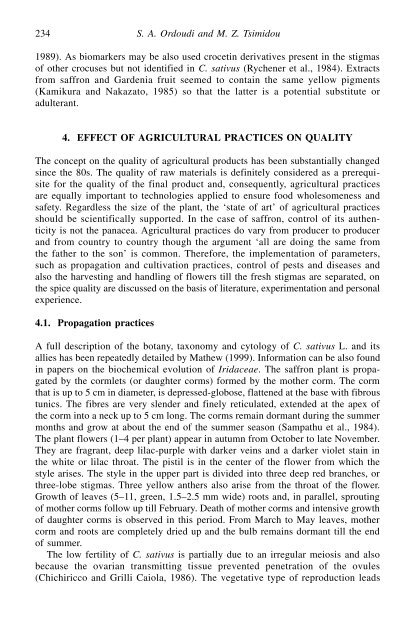Production Practices and Quality Assessment of Food Crops. Vol. 1
Production Practices and Quality Assessment of Food Crops. Vol. 1
Production Practices and Quality Assessment of Food Crops. Vol. 1
You also want an ePaper? Increase the reach of your titles
YUMPU automatically turns print PDFs into web optimized ePapers that Google loves.
234 S. A. Ordoudi <strong>and</strong> M. Z. Tsimidou<br />
1989). As biomarkers may be also used crocetin derivatives present in the stigmas<br />
<strong>of</strong> other crocuses but not identified in C. sativus (Rychener et al., 1984). Extracts<br />
from saffron <strong>and</strong> Gardenia fruit seemed to contain the same yellow pigments<br />
(Kamikura <strong>and</strong> Nakazato, 1985) so that the latter is a potential substitute or<br />
adulterant.<br />
4. EFFECT OF AGRICULTURAL PRACTICES ON QUALITY<br />
The concept on the quality <strong>of</strong> agricultural products has been substantially changed<br />
since the 80s. The quality <strong>of</strong> raw materials is definitely considered as a prerequisite<br />
for the quality <strong>of</strong> the final product <strong>and</strong>, consequently, agricultural practices<br />
are equally important to technologies applied to ensure food wholesomeness <strong>and</strong><br />
safety. Regardless the size <strong>of</strong> the plant, the ‘state <strong>of</strong> art’ <strong>of</strong> agricultural practices<br />
should be scientifically supported. In the case <strong>of</strong> saffron, control <strong>of</strong> its authenticity<br />
is not the panacea. Agricultural practices do vary from producer to producer<br />
<strong>and</strong> from country to country though the argument ‘all are doing the same from<br />
the father to the son’ is common. Therefore, the implementation <strong>of</strong> parameters,<br />
such as propagation <strong>and</strong> cultivation practices, control <strong>of</strong> pests <strong>and</strong> diseases <strong>and</strong><br />
also the harvesting <strong>and</strong> h<strong>and</strong>ling <strong>of</strong> flowers till the fresh stigmas are separated, on<br />
the spice quality are discussed on the basis <strong>of</strong> literature, experimentation <strong>and</strong> personal<br />
experience.<br />
4.1. Propagation practices<br />
A full description <strong>of</strong> the botany, taxonomy <strong>and</strong> cytology <strong>of</strong> C. sativus L. <strong>and</strong> its<br />
allies has been repeatedly detailed by Mathew (1999). Information can be also found<br />
in papers on the biochemical evolution <strong>of</strong> Iridaceae. The saffron plant is propagated<br />
by the cormlets (or daughter corms) formed by the mother corm. The corm<br />
that is up to 5 cm in diameter, is depressed-globose, flattened at the base with fibrous<br />
tunics. The fibres are very slender <strong>and</strong> finely reticulated, extended at the apex <strong>of</strong><br />
the corm into a neck up to 5 cm long. The corms remain dormant during the summer<br />
months <strong>and</strong> grow at about the end <strong>of</strong> the summer season (Sampathu et al., 1984).<br />
The plant flowers (1–4 per plant) appear in autumn from October to late November.<br />
They are fragrant, deep lilac-purple with darker veins <strong>and</strong> a darker violet stain in<br />
the white or lilac throat. The pistil is in the center <strong>of</strong> the flower from which the<br />
style arises. The style in the upper part is divided into three deep red branches, or<br />
three-lobe stigmas. Three yellow anthers also arise from the throat <strong>of</strong> the flower.<br />
Growth <strong>of</strong> leaves (5–11, green, 1.5–2.5 mm wide) roots <strong>and</strong>, in parallel, sprouting<br />
<strong>of</strong> mother corms follow up till February. Death <strong>of</strong> mother corms <strong>and</strong> intensive growth<br />
<strong>of</strong> daughter corms is observed in this period. From March to May leaves, mother<br />
corm <strong>and</strong> roots are completely dried up <strong>and</strong> the bulb remains dormant till the end<br />
<strong>of</strong> summer.<br />
The low fertility <strong>of</strong> C. sativus is partially due to an irregular meiosis <strong>and</strong> also<br />
because the ovarian transmitting tissue prevented penetration <strong>of</strong> the ovules<br />
(Chichiricco <strong>and</strong> Grilli Caiola, 1986). The vegetative type <strong>of</strong> reproduction leads

















